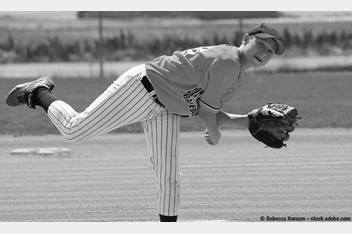Sports Medicine: Osteochondritis Dissecans of the Capitellum (OCD)
The elbow joint is made up of 3 bones – 1 upper arm bone (humerus) and 2 forearm bones (ulna and radius). At the lower end of the humerus are 2 smooth articular surfaces, the trochlea (on the inside of the elbow) and the capitellum (on the outside of the elbow). Osteochondritis dissecans (os-tee-o-kon-DRY-tis DIS-uh-kanz) of the capitellum (OCD) is a condition that affects the outside surface of the elbow that involves a separation of a segment of cartilage and the underlying bone. The bone underneath the joint’s cartilage is damaged due to lack of blood flow, causing pain.
Signs and Symptoms
- pain on the outside of the elbow that gets worse with throwing or lifting heavy objects
- pain with weight bearing on the arms
- locking or catching of the joint
- swelling
Increased Risk
- sports involving overhead activity or repetitive stress on the elbow (baseball or gymnastics)
- males
- people between the age of 11 to 23 years
- personal or family history of OCD
Treatment
- Medicine
- Anti-inflammatory medicines, such as ibuprofen (Motrin® or Advil®) or naproxen (Aleve®), may be recommended. Take these as directed by your health care provider.
- Other minor pain relievers, such as acetaminophen (Tylenol®).
- Use of cold and heat
- Cold should be applied for 10 to 15 minutes every 2 to 3 hours for swelling and after any activity that makes symptoms worse. Use ice packs or an ice massage.
- Heat should not be used on a new injury but may be used before performing stretching and strengthening activities prescribed by your health care provider or athletic trainer. Use a heat pack or warm soak. Apply for 10 to 15 minutes.
- Rest
- Rest from sports or impact activities for up to 6 months, sometimes longer, may be advised.
- Orthopedic aids
- A splint or cast to restrain the joint may be helpful if there is a lot of pain with daily activity.
- Exercises
- Exercises to improve strength, flexibility, and proper body mechanics are important. These can be done at home, but often a referral to a physical therapist or athletic trainer may be advised by your health care provider.
- Surgery
- Surgery may be needed for patients with on-going pain, unstable lesions, or lesions that do not heal with rest.
How to Prevent
- Do correct warm-up and stretching before practice or competition.
- Follow pitch count guidelines.
- Maintain proper conditioning, strength, flexibility, endurance, and cardiovascular fitness.
When to Call the Health Care Provider
Call your health care provider or the Sports Medicine team at (614) 355-6000 if:
- symptoms get worse after 2 weeks, even with treatment
- new, unexplained symptoms develop
HH-I-544 ©2022, Nationwide Children’s Hospital

